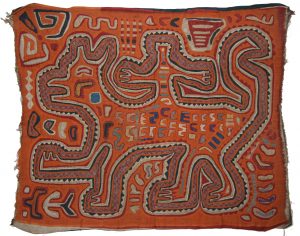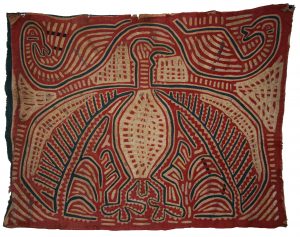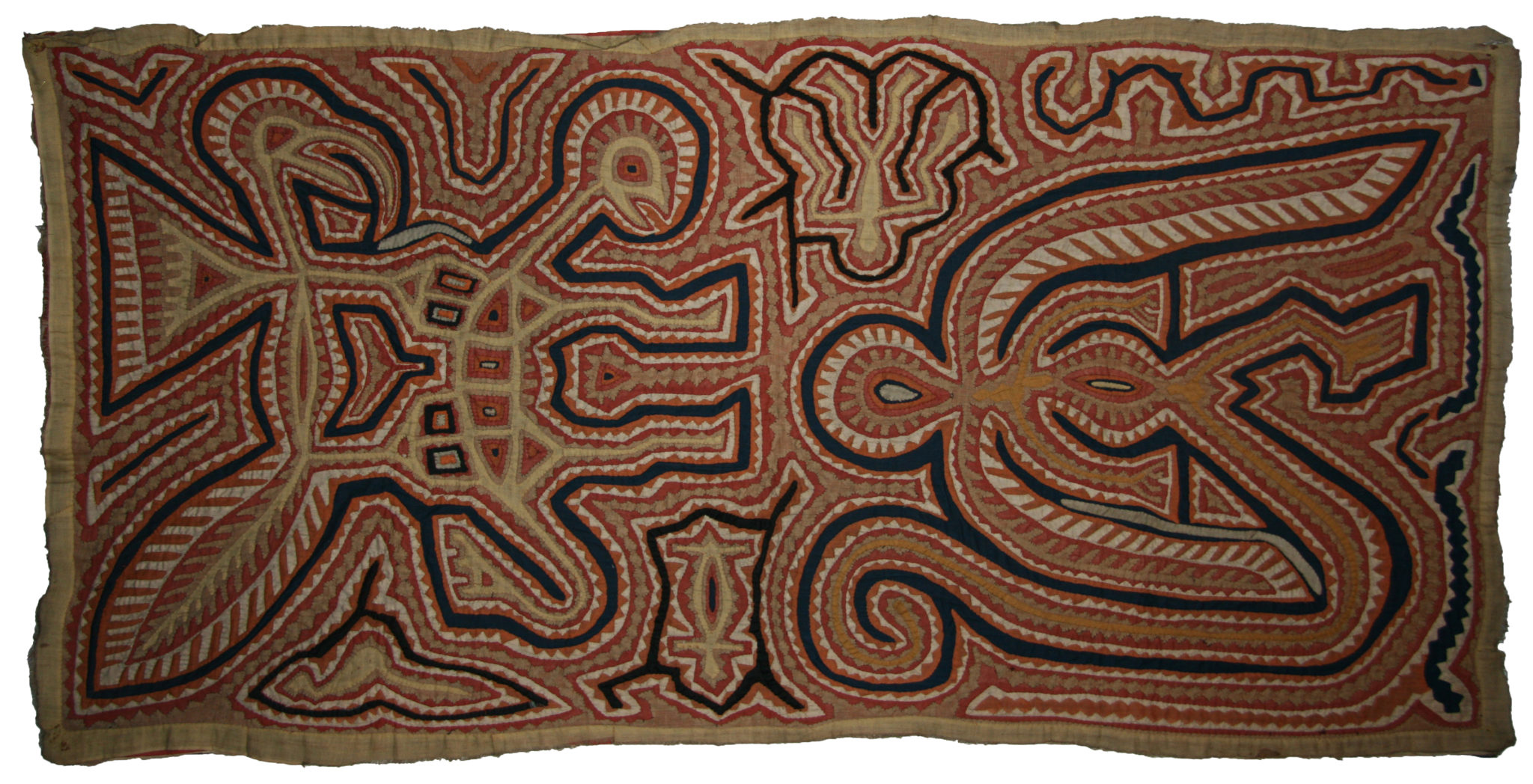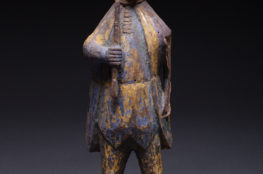Modern molas are often 14′” – 17″ wide, because modern Guna women usually prefer a tight-fitting blouse. In the 1960s the average mola was 19″ – 21″ wide, because women then preferred a looser fit. In the 1920s and 1930s mola blouses were much larger, averaging 23″ – 25″ in width. There are some new mola panels being sold in Panama City that are the size of tablecloths — but those are clearly made for tourists. Far more interesting are huge molas made in the 1920s, 1930s and 1940s. The orange “purba” mola (showing a four legged animal with a being/spirit rising out of its back) is 26″ wide by 22″ high. It was likely part of a blouse of a larger woman. But the red/gold “batesor” mola (with large circular motifs) is 31″ wide by 18.5″ high — much too large to be a blouse panel. The blue eagle or “wekko” bird mola was collected in the 1920s by Captain Wayne Stukey and is 29.5″ x 22.5″…also too large to have been used in a blouse. And the large, yellow, vertically-oriented panel with a purba image and the abstract image of a winged monkey is 45.5″ x 22.5″!
There are similarly large, early examples of molas in the collection of the Smithsonian Institution. The question is, “How were they used?” We don’t know of any historical examples of the Gunadule people using mola textiles as wall-hangings, table cloths or “altar” coverings. So perhaps these gigantic mola panels were “made for us.” Specially crafted for sale to outside visitors.
For now, these “molagana dummat” remain a mystery.






March 23, 2019
Hi, Mr. Hannaher. I apologize, but is easier for me to express myself in Spanish.
Michel Perrin en su obra “TABLEAUX KUNA. Les Molas un Art D’Amérique” (p. 27) afirma lo siguiente:
Las primeras molas tenían forma de rectángulo vertical (fig. 1 y 2). Luego, el formato se invierte para enmarcarse en un rectángulo horizontal, y su tamaño disminuye…
Aunque Perrin no brinda más información al respecto, la fig. 2 (p. 22) exhibe la foto de una joven guna alrededor de 1910, que denota lo siguiente: La orientación vertical de las primeras molas coincide con la forma y el largo de la blusa de la mujer guna. Por lo tanto, es posible deducir que la transformación del formato de las molas se relaciona directamente con los cambios que ha tenido la blusa femenina alrededor de 100 años de existencia.
March 23, 2019
Hi Meyby! Good to hear from you. Perrin cites two images to substantiate his theory — both on page 22 of his book. The top image is a line art rendering of a wonderful mola collected by Eleanor Yorke Bell in 1906, which is pictured as Plate 9 in the 1909 Smithsonian Annual Report. The mola is pictured vertically to more properly fill the vertically-shaped page — but the imagery is frequently found in later molas that show the figure in a horizontal format. Also the mola is listed at being 21″ x 17″ — not nearly as large as any of the examples we have shown here.
Perrin’s second illustration — the photo of the Guna woman wearing a large, dress-like mola blouse, is a wonderful example of a very large early mola. I had forgotten about this image, so thank you and Mr. Perrin for bringing it to my attention. This mola is not dominated by one or two large images. Instead it has numerous smaller images that could, I believe, be “aimed either way.” And if the woman was typical, she was about five feet tall (150 cm). If that’s true then this “tall mola” is probably about 27″-30″ high (69-76 cm)…but not nearly as wide.
So it would seem possible that the batesor, purba and eagle molas might have been worn as parts of blouses like the one in Perrin’s example. But the 45″ (114 cm) example is as high as most Guna women of that time! That piece and ones of similar size in the Smithsonian collection remain mysteries.
April 27, 2019
Gracias por la explicación, muy interesante.
Me encantaría ver algún día esas molas gigantes del Smithsonian!